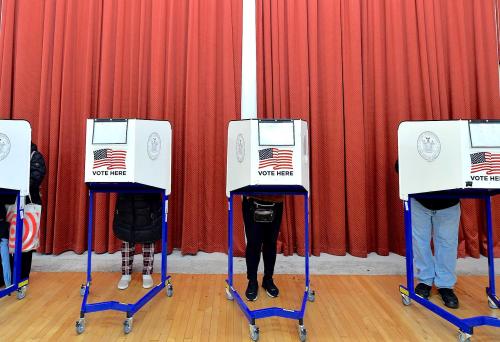All signs indicate that 2014 and 2016 will be banner years for women in politics. With Hillary Clinton as the frontrunner for the Democratic nomination and a growing list of other women from both parties throwing their hats into the ring, it’s a good bet that we’ll see at least one female presidential candidate. And the prevalence of women candidates does not stop with the presidential ticket. The press office from the National Republican Congressional Committee said that they are experiencing unprecedented success in recruiting exceptionally qualified women to compete for Congressional seats, and media reports suggest the same is true for Democrats. This begs the question: why are women choosing to run now?
One possibility is that perceptions of female politicians – and, by extension, their odds of winning at the polls – are better than ever. The public is fed up with the constant gridlock and bickering in the federal government–where a man holds the presidency and men hold 80% of seats in the Senate and 82.1% in the House. In a world where stalemate has become the norm, women are seen as a beacon of hope.
Adding to these perceptions is the fact that the shutdown provided women with the opportunity to demonstrate their legislative prowess. Senators John McCain (R-AZ) and Mark Pryor (D-AR) commented that their female colleagues deserve most of the credit for driving the compromise to reopen the U.S. government. Of the 14 senators on the bipartisan committee that laid the foundation for that deal, six were women – a far better ratio than exists in the Senate as a whole. Senator Susan Collins (R-ME), who started the group, told the New York Times that she didn’t think it was a coincidence that women played such a prominent role in forging the budget compromise: “Although we span the ideological spectrum, we are used to working together in a collaborative way.” Her sentiments were echoed by Senator Amy Klobuchar (D-MN), who was also part of the group. She noted the strong friendships of trust that exist with all 20 women in the Senate – friendships that help them legislate effectively and responsibly compared to their male colleagues.
The reputation of women as consensus builders in Congress is not just a phenomenon of the shutdown. Women and men have inherently different leadership approaches, and there is a substantial academic literature to prove it. Decades of research shows that male legislators tend to be individualist and competitive, while women are more collaborative and consensus driven. As former Representative Barbara Jordan (D-TX) said in 1991, “Women have a capacity for understanding and compassion which a man structurally does not have.”
But women’s political edge transcends their “structural” advantage. Female legislators invest more time building within- and across-party coalitions with both men and women – and it pays off. In a recently published study of the U.S. Congress from 1973-2008, Volden, Wiseman, and Wittmer show that female legislators are 10% more effective (meaning that the bills they sponsor are more likely to pass) than their male counterparts. Moreover, minority party status – typically viewed as crippling to one’s agenda – is not nearly as much of a detriment to women. Indeed, women are 28% more effective than men when in the minority party—regardless of whether those female legislators are moderates or mainstream partisans. Put simply, women’s capacity (and willingness) to collaborate with those across the aisle makes them better legislators.
The shutdown highlighted women’s ability to act when men weren’t able to get the job done. Thus, one clear lesson from the shutdown is that having women in government is a really good thing. As Harvard Kennedy School Lecturer Swanee Hunt put it, “We can stop the cross-aisle squabbling. Elect more women. We know how to do it.”
Gender, then, has become a strategic advantage for women running for office – making the odds of winning as a female candidate particularly good. So, it is not surprising that more women are seizing this opportunity to run. Moreover, since the expected payoffs from running are particularly high, we should expect the pool of female candidates to be exceptionally strong. Qualified women may have been discouraged from running in previous elections if the opportunity costs associated with a campaign exceeded the expected benefits: businesses (and families) must be put on hold or lower-level political roles must be relinquished. Yet, with the increased probability of success, they may be willing to give it a shot now, even if they weren’t in the past. As a result, 2014 (or 2016) may not just be the “Year of the Women” – it could be the year that puts the nation back on track toward effective governance.
The Brookings Institution is committed to quality, independence, and impact.
We are supported by a diverse array of funders. In line with our values and policies, each Brookings publication represents the sole views of its author(s).



Commentary
More Women = Less Gridlock: How 2014 & 2016 May Reshape Politics
November 8, 2013